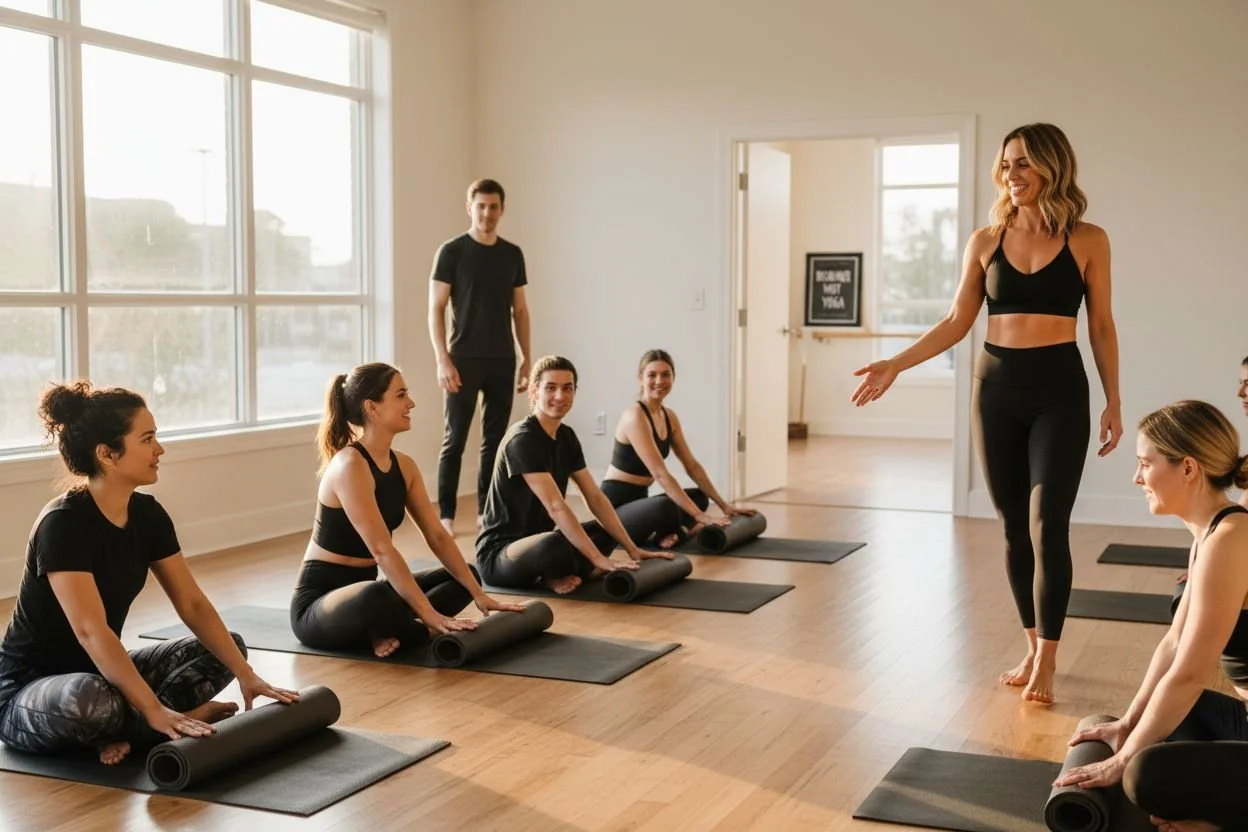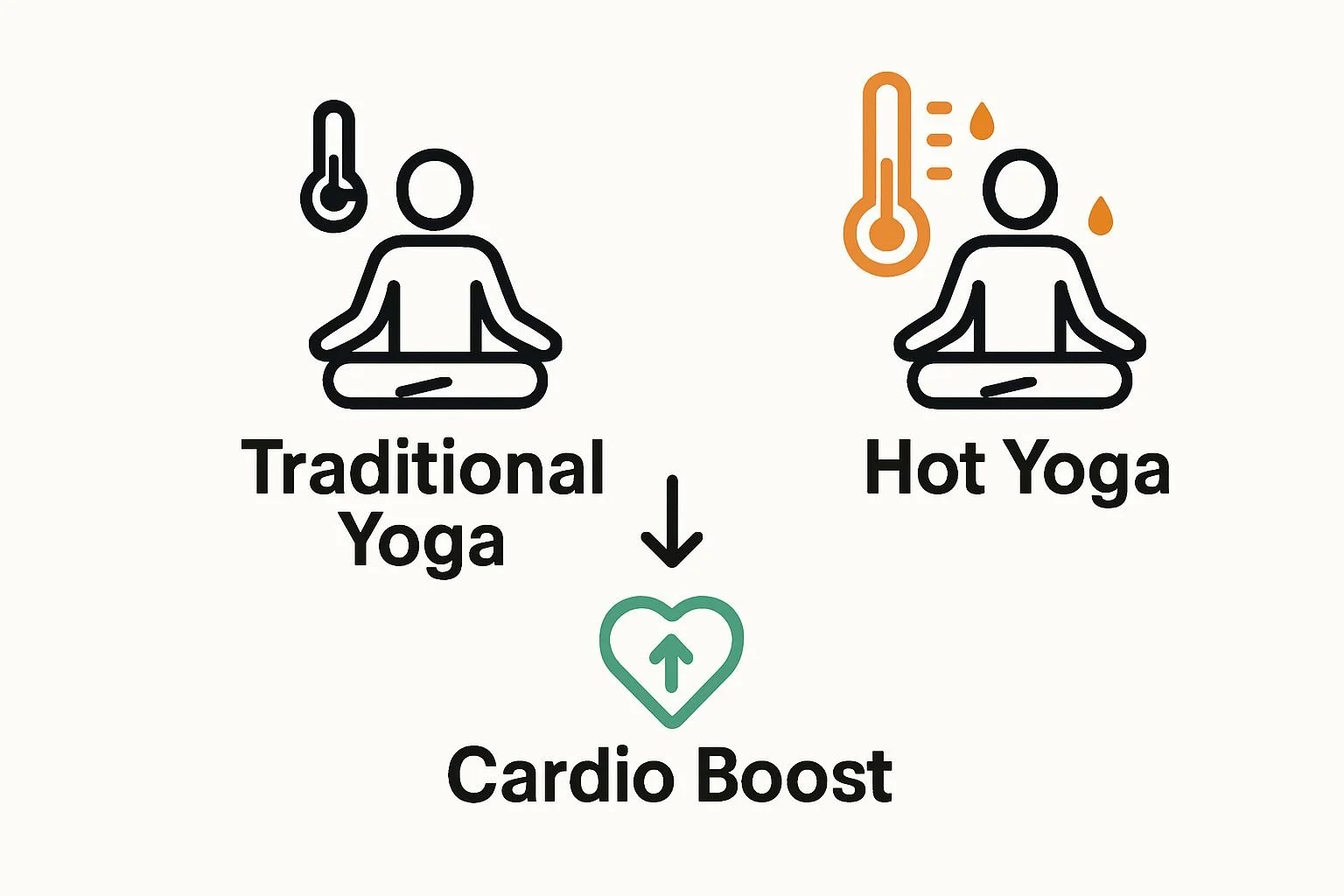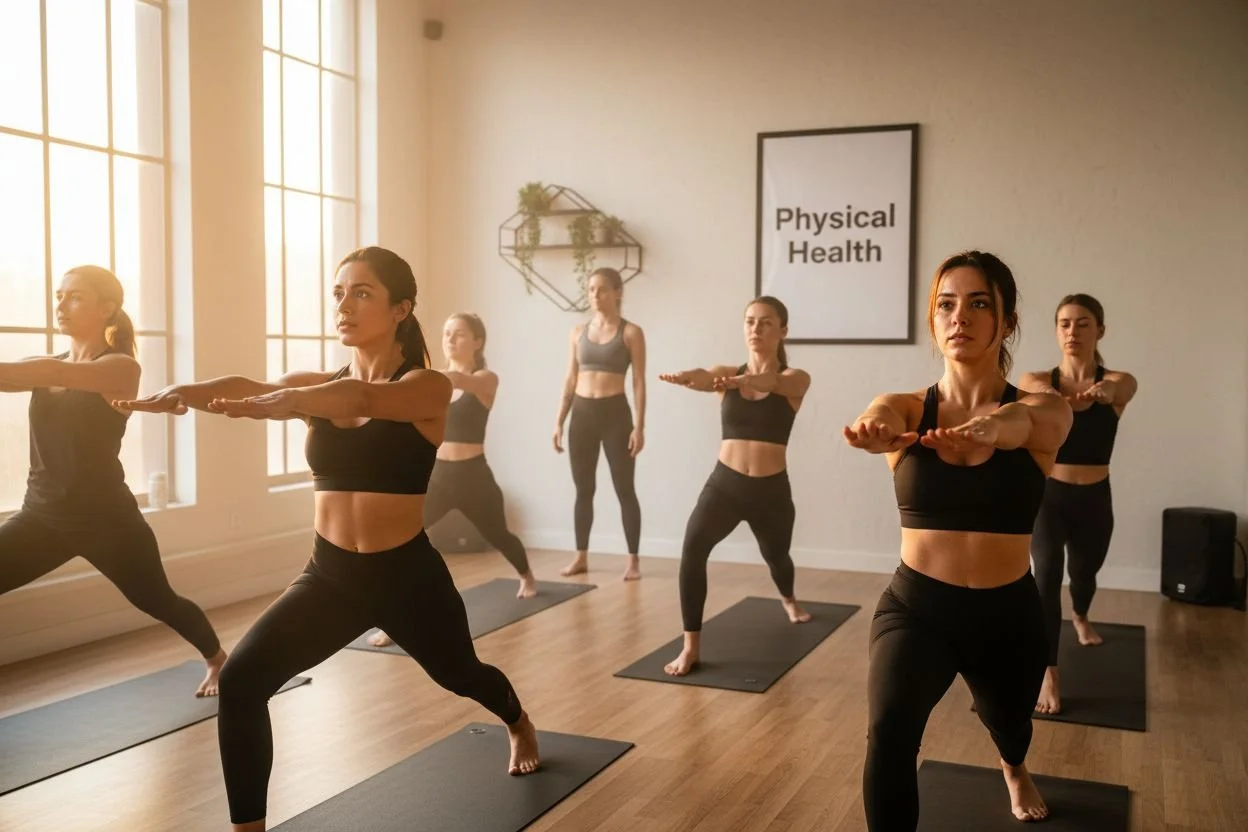Understanding the Beginner Hot Yoga Guide for Wellness
Heather Rice
Hot yoga is changing how people experience both exercise and relaxation, with studios heated anywhere from 90 to 105°F and humidity often reaching 40%. You might expect these intense temperatures to scare people away. Strangely, they keep coming back for more, and the mental benefits might be even hotter than the physical ones.
Table of Contents
Quick Summary
| Takeaway | Explanation |
|---|---|
| Hot yoga enhances flexibility and strength. | The heat promotes improved muscle elasticity and increased range of motion, reducing injury risks during practice. |
| Mental focus is developed through challenges. | Practicing in a heated environment trains individuals to maintain composure and increases stress management skills effectively. |
| Hydration is crucial before hot yoga. | Proper hydration prevents dehydration and enhances performance and comfort during the intense practice sessions. |
| Beginner modifications support safe practice. | Beginners should use available modifications to ensure they engage safely and effectively with the practice tailored to their fitness levels. |
| Hot yoga fosters a mind–body connection. | The practice encourages deep awareness of bodily sensations and promotes overall holistic wellness and personal growth through intentional focus. |
What is Hot Yoga and Its Unique Environment?
Hot yoga represents a transformative wellness practice that elevates traditional yoga through strategic environmental manipulation. Unlike standard yoga classes, hot yoga creates an intentionally heated studio space designed to challenge and support practitioners through intense physiological experiences.
The Heated Landscape of Yoga Practice
Hot yoga classrooms are deliberately maintained at high temperatures, typically ranging between 90–105°F (32–40°C), with humidity levels often reaching 40%. According to medical research, these carefully controlled environmental conditions serve multiple physiological purposes beyond traditional yoga practice. The intense heat acts as a catalyst for deeper bodily engagement, promoting increased flexibility, enhanced cardiovascular performance, and accelerated metabolic processes.
Physiological Responses and Benefits
The unique hot yoga environment triggers significant bodily adaptations. Practitioners experience:
Accelerated sweating and enhanced detoxification
Increased heart rate mimicking cardiovascular exercise
Improved muscle elasticity and reduced injury risk
Enhanced mental focus through challenging environmental conditions
By challenging the body's thermoregulatory systems, hot yoga creates a holistic wellness experience that goes far beyond standard yoga practice. If you want to explore different hot yoga styles, understanding the foundational principles of this dynamic practice is crucial.
Unlike traditional yoga practices performed in neutral temperatures, hot yoga intentionally stresses the body's adaptive mechanisms. This controlled environmental stress prompts physiological responses that can enhance overall fitness, mental resilience, and somatic awareness. Practitioners learn to maintain calm and focus while navigating intense physical conditions, developing a profound mind body connection through deliberate practice.
Why Hot Yoga Matters for Physical and Mental Health
Hot yoga transcends traditional exercise by offering profound benefits that address both physical conditioning and psychological well-being. This comprehensive practice uniquely integrates bodily movement with intentional mental discipline, creating a holistic approach to personal health and wellness.
Physical Health Transformation
Scientific researchdemonstrates that hot yoga produces remarkable physiological adaptations. Regular practitioners experience significant improvements in multiple health metrics, including enhanced cardiovascular endurance, improved muscular strength, and increased metabolic efficiency. The heated environment challenges the body to work more intensely, triggering adaptive responses that contribute to overall fitness and resilience.
Key physical benefits include:
Enhanced muscular flexibility and range of motion
Accelerated calorie burning and metabolic performance
Improved cardiovascular conditioning
Strengthened immune system response
Psychological and Emotional Wellness
Beyond physical transformations, hot yoga serves as a powerful mental health intervention. The practice demands intense focus and emotional regulation, training practitioners to maintain composure under challenging conditions. By navigating the demanding environmental conditions, individuals develop psychological resilience and stress management capabilities.
The meditative aspects of hot yoga promote mindfulness, helping practitioners cultivate a deeper connection between mental and physical experiences. Learn more about our yoga class approaches that emphasize holistic wellness and personal growth.
Ultimately, hot yoga represents more than just a fitness routine. It is a comprehensive approach to wellness that simultaneously challenges and nurtures the human body and mind, offering practitioners a transformative path toward improved health, mental clarity, and emotional balance.
Below is a table summarizing the key physical and mental benefits of hot yoga for practitioners, making it easier to scan health outcomes mentioned in the article.
Benefits of Hot Yoga
| Benefit Type | Specific Benefits | How Hot Yoga Contributes |
|---|---|---|
| Physical | Enhanced flexibility and range of motion | Heat loosens muscles, improving elasticity |
| Physical | Improved cardiovascular conditioning | Elevated heart rate mimics cardio workouts |
| Physical | Accelerated calorie burning and metabolic performance | Temperature increases metabolic demands |
| Physical | Strengthened immune system response | Exposure to controlled stress boosts adaptive response |
| Mental/Psychological | Increased mental focus and stress management | Challenging environment demands concentration |
| Mental/Psychological | Heightened mindfulness and mind–body connection | Practice encourages deep awareness |
| Mental/Psychological | Enhanced emotional regulation and resilience | Exposure to heat triggers adaptive coping |
How Hot Yoga Benefits Beginners: Key Concepts Explained
Hot yoga represents a powerful entry point into wellness practices for beginners, offering a transformative experience that goes beyond traditional fitness approaches. This practice provides a structured yet adaptable environment where new practitioners can develop physical strength, mental resilience, and holistic health awareness.
Understanding the Beginner's Journey
According to medical research, hot yoga can provide a sense of accomplishment and confidence for newcomers as they complete challenging sessions. The practice offers a supportive framework for individuals seeking to improve their overall wellness, with modifications available to accommodate different fitness levels and physical capabilities.
Key considerations for beginners include:
Gradual adaptation to heated environments
Importance of proper hydration
Listening to body signals and personal limits
Maintaining consistent but gentle practice
Building Foundational Skills and Confidence
Hot yoga introduces beginners to a comprehensive approach of physical and mental conditioning. The practice teaches fundamental skills such as breath control, body awareness, and stress management. Practitioners learn to navigate challenging physical conditions while maintaining mental composure, a skill that translates directly into everyday life challenges.
For those interested in exploring structured learning approaches, our yoga class offerings provide tailored guidance for newcomers seeking a supportive introduction to hot yoga practices.
The beauty of hot yoga for beginners lies in its scalable nature. Unlike intimidating fitness regimens, this practice welcomes individuals at all fitness levels, emphasizing personal growth and self-discovery over competitive performance. By focusing on individual progress and personal well-being, hot yoga creates an inclusive environment where every practitioner can develop strength, flexibility, and inner peace at their own pace.
The Science Behind Hot Yoga: How It Works in Your Body
Hot yoga represents a sophisticated physiological intervention that leverages environmental conditions to trigger complex bodily adaptations. Far from being a simple exercise routine, this practice strategically manipulates human biological systems to promote comprehensive wellness and performance enhancement.
Thermoregulatory Responses and Metabolic Activation
Scientific studiesreveal that heated yoga environments stimulate profound physiological responses. When practitioners enter a heated studio, their bodies immediately activate intricate thermoregulatory mechanisms designed to maintain core temperature and manage environmental stress.
Key physiological processes include:
Increased cardiovascular circulation
Enhanced metabolic rate and enzyme activity
Accelerated perspiration for temperature regulation
Rapid activation of sympathetic nervous system responses
Cellular and Systemic Adaptation Mechanisms
The human body responds to hot yoga's challenging environment through adaptive stress responses. These responses trigger multiple beneficial biochemical cascades that improve overall physiological resilience. Repeated exposure to controlled heat stress promotes mitochondrial efficiency, increases heat shock protein production, and enhances cellular repair mechanisms.
Explore our deep dive into hot yoga techniquesto understand the intricate biological transformations occurring during practice.
Beyond immediate physical responses, hot yoga initiates long-term neurological and metabolic adaptations. Practitioners develop improved temperature tolerance, more efficient cardiovascular performance, and enhanced stress management capabilities.
The practice essentially trains the body to become more resilient, transforming environmental challenges into opportunities for holistic physiological optimization.
Understanding Safety and Best Practices for Newcomers
Navigating hot yoga as a beginner requires thoughtful preparation and a strategic approach to personal wellness. Understanding the unique challenges of this practice is crucial for ensuring a safe, positive, and transformative experience that supports long-term health and fitness goals.
Pre-Practice Preparation and Awareness
According to health guidelines, newcomers must prioritize comprehensive preparation before entering a hot yoga environment. This involves more than simply showing up to class.Proper hydration, appropriate clothing selection, and understanding personal physical limitations are fundamental to a successful practice.
Key preparatory considerations include:
Hydrating extensively before class
Consuming light, nutritious meals
Wearing breathable, moisture-wicking clothing
Bringing multiple towels and water bottles
Informing instructors about any health conditions
Managing Physical Responses and Personal Boundaries
Hot yoga challenges practitioners to develop heightened body awareness and self-regulation skills. Newcomers should approach the practice with a mindset of curiosity and gentle self-observation rather than competitive performance. Learning to recognize and respect personal physiological signals is more important than completing every pose or staying in the heated room for the entire session.
Learn more about our beginner-friendly yoga approaches that emphasize safety and individual progression.
The most successful hot yoga practitioners understand that progress is not linear and that each session represents a unique bodily experience. By cultivating patience, maintaining open communication with instructors, and developing a nuanced understanding of personal physical responses, newcomers can transform potential challenges into opportunities for growth and self-discovery.
The table below organizes best practices for newcomers starting hot yoga, outlining preparation steps and in-class safety recommendations highlighted in the article.
Hot Yoga Practices & Precautions
| Stage | Practice or Precaution | Purpose/Benefit |
|---|---|---|
| Pre-Practice | Hydrate extensively before class | Prevent dehydration, improve comfort |
| Pre-Practice | Eat light, nutritious meals | Provide energy without heaviness |
| Pre-Practice | Wear breathable, moisture-wicking clothing | Maximize comfort, facilitate heat regulation |
| Pre-Practice | Inform instructors about health conditions | Receive appropriate modifications, ensure safety |
| During Practice | Bring towels and water for class | Manage sweat, stay hydrated |
| During Practice | Listen to body signals, respect limits | Avoid overexertion and heat-related issues |
| During Practice | Take breaks or use child’s pose if needed | Support self-care, maintain well-being |
Start Your Hot Yoga Journey With Confidence at Amrita Yoga & Wellness
Feeling overwhelmed by the idea of starting hot yoga? The article highlighted common beginner challenges such as adapting to intense heat, understanding safe practices, and building foundational confidence. At Amrita Yoga & Wellness in Philadelphia, we provide a safe and welcoming environment designed specifically for newcomers like you. Our instructors are experienced in helping you manage hydration, build body awareness, and develop the resilience needed to thrive in your wellness journey.
Take the next step to prioritize your physical and mental well-being. Visit our home page to find class times, read detailed descriptions of our yoga classes, and experience why our supportive community is the perfect place for beginners. Spots fill up quickly for new member classes. Begin your path to greater strength and peace of mind at Amrita Yoga & Wellness today.
Frequently Asked Questions
What should I know before starting hot yoga as a beginner?
Before starting hot yoga, ensure you understand the importance of hydration and listen to your body signals. Prepare by drinking plenty of water, wearing breathable clothing, and informing your instructor of any health issues. Take time to explore introductory classes that cater to beginners.
How can I effectively acclimate to the heat in hot yoga?
To acclimate to the heat, start with shorter sessions and gradually increase your exposure over a few weeks. Begin with classes that are slightly less intense, allowing your body to adjust while you build tolerance to the higher temperatures.
What are some recommended practices for maximizing my hot yoga experience?
To maximize your hot yoga experience, practice mindfulness, focus on your breath, and embrace the challenging environment. Consider performing gentle poses after the class to help maintain flexibility and reduce soreness.
How can I manage discomfort during a hot yoga session?
If you experience discomfort, take a moment to rest and hydrate, and use a towel for sweat management. Allow yourself to pause in child’s pose or lay down if necessary, and remember to focus on your breathing to help maintain calmness.
What steps should I take after a hot yoga class to support my recovery?
After a hot yoga class, replenish your body with water and a light snack rich in protein or healthy carbs. Stretch gently at home to maintain flexibility, and schedule regular classes to build consistency in your practice.
How can I track my progress in hot yoga as a beginner?
To track your progress in hot yoga, keep a journal detailing your experiences, including the poses you learned and how you felt during each session. Aim for improvement within 30 days by noting increased flexibility, strength, and mental focus over time.



